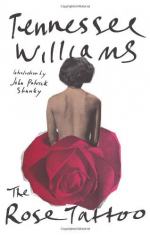|
This section contains 5,417 words (approx. 14 pages at 400 words per page) |

|
In the following essay, Starnes explores the regional and ethnic melange Williams mixes to give his characters their odd dialogue and bearing in The Rose Tattoo.
That realism should be the convention fundamental to the work of Tennessee Williams is altogether logical. Until his late adolescence, Williams had little opportunity to see any form of theater other than the American cinema, and this form, of course, is firmly grounded in the realistic approach. Even the external shape of Williams's theater shows especially clear evidence of this cinematic influence: a succession of episodes, "fade-outs" and "fade-ins," background music, gauze scrims, and expressive lights focussed to simulate "close-ups"—all devices immediately recognizable as film technique, itself a more poetic kind of realism.
Often clearly aspiring to the conditions of poetry, Williams creates for himself an advantage which is not always available to other dramatists who start from the...
|
This section contains 5,417 words (approx. 14 pages at 400 words per page) |

|




